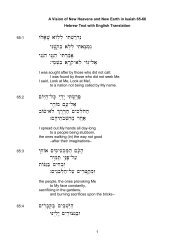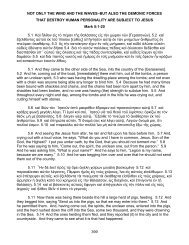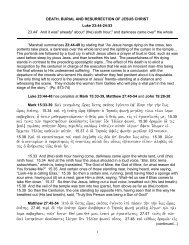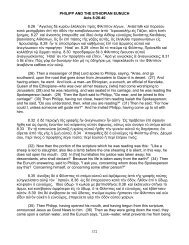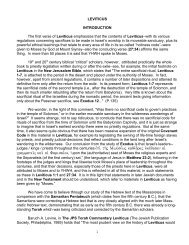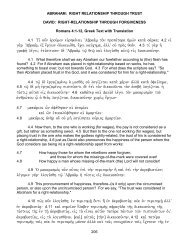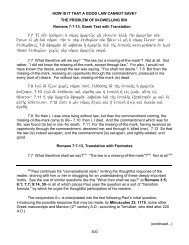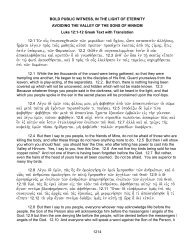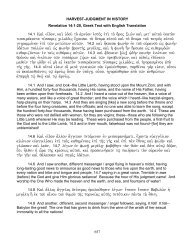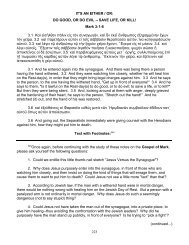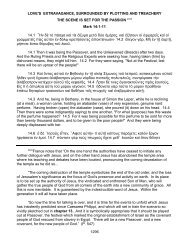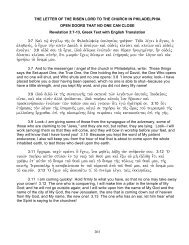Revelation 8-9 - In Depth Bible Commentaries
Revelation 8-9 - In Depth Bible Commentaries
Revelation 8-9 - In Depth Bible Commentaries
You also want an ePaper? Increase the reach of your titles
YUMPU automatically turns print PDFs into web optimized ePapers that Google loves.
953like faces of people. 9.8 And they were having hair like women's hair; and their teeth were like954 955[those] of lions. 9.9 And they were having breastplates like iron breastplates, and the sound953It has been suggested that John has reference to the long "antennae" of locusts orgrasshoppers, which have some similarity to women's long hair.Aune states that “This probably means that their hair was long and possibly disheveled.Disheveled hair had several meanings in the Old Testament: (1) as a sign of uncleanness forpeople with leprosy (Leviticus 13:45), (2) as a sign of mourning (Leviticus 10:6; 21:10), and(3) as part of the sacrificial protocol for a woman accused of adultery (Numbers 5:18)... Parthianwarriors wore their hair long...and many interpreters have understood the demonic locustarmy as mytho-poetic imagery for the Parthian threat.” (P. 532)Historicist interpreters such as Eliott and Barnes “present reasons why the descriptionof the locusts (verse 7) provides a particularly apt symbol of the Islamic hordes. MidianiteArab hordes are likened, as to their numbers, to locusts invading (Judges 6:5). Islamic traditionspeaks of locusts having dropped into the hands of Mohammed, bearing on their wingsthis inscription: ‘We are the army of the Great God’...Their traditional turbans can be seen ascrowns (verse 7). The description of having faces of men (verse 7) and hair like women’s hair(verse 8) is seen as a reference to their bearded, long-haired heads...The breastplates of iron(verse 9) were literal. The Saracens had iron coats of mail. The Koran says: ‘God has givenyou coats of mail to defend you in your wars.’ The stings in their tails (verse 10) may refer tothe fact that the Saracens were known to be adept at fighting rearward over the tails of theirhorses.” (Gregg, pp. 182, 184)Preterist interpreters interpret the locusts as being “a portrayal of armies of demons thatafflicted the whole society of the Jews during their conflicts with the Romans...The descriptionis perhaps mingled with some features of the demonized zealots who made life so miserablefor their fellow Jews during the siege [and]...who gave themselves up to effeminate practices,plaiting their hair and putting on women’s clothes...” (Gregg, pp. 182, 184)Once again we ask, “Why this great difference in interpretation of John’s propheticvision?” “Is it because interpreters are dishonest, that they are ‘false teachers,’ purposelytrying to lead people astray? We think not. We think these differences in interpretation arisefrom the nature of the “prophetic vision”–see Numbers 12:6-8 and 1 Corinthians 13:9-12. <strong>In</strong>fact, this is exactly what we should expect from such material! It is capable of beinginterpreted in sharply differing ways–but that does not make it meaningless. It calls for all theskills we can muster in interpretation, and at the same time warns against dogmatism ininterpretation!954That is, these grasshoppers, instead of being harmless to humans (as are normalgrasshoppers), appear to be ferocious, able to bite and destroy with their teeth. Aune commentsthat “Like the teeth of a lion” is a “proverbial expression for something irresistibly andfatally destructive (Ben Sirach 21:2 [‘Flee from sin as from a snake; for if you approach sin, itwill bite you’]; compare Job 4:10). This is an allusion to Joel 1:6...<strong>In</strong> Psalm 57:4 the psalmist(continued...)443



